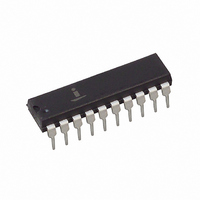X9221UP Intersil, X9221UP Datasheet - Page 3

X9221UP
Manufacturer Part Number
X9221UP
Description
IC DCP DUAL 50K 64TP 20DIP
Manufacturer
Intersil
Series
XDCP™r
Datasheet
1.X9221UP.pdf
(15 pages)
Specifications of X9221UP
Taps
64
Resistance (ohms)
50K
Number Of Circuits
2
Temperature Coefficient
30 ppm/°C Typical
Memory Type
Non-Volatile
Interface
I²C, 2-Wire Serial
Voltage - Supply
4.5 V ~ 5.5 V
Operating Temperature
0°C ~ 70°C
Mounting Type
Through Hole
Package / Case
20-DIP (0.300", 7.62mm)
Resistance In Ohms
50K
Lead Free Status / RoHS Status
Contains lead / RoHS non-compliant
Available stocks
Company
Part Number
Manufacturer
Quantity
Price
Company:
Part Number:
X9221UP
Manufacturer:
Intersil
Quantity:
2 150
Part Number:
X9221UP
Manufacturer:
WOLFSON
Quantity:
20 000
X9221
Acknowledge
Acknowledge is a software convention used to provide
a positive handshake between the master and slave
devices on the bus to indicate the successful receipt of
data. The transmitting device, either the master or the
slave, will release the SDA bus after transmitting eight
bits. The master generates a ninth clock cycle and dur-
ing this period the receiver pulls the SDA line LOW to
acknowledge that it successfully received the eight bits
of data. See Figure 7.
The X9221 will respond with an acknowledge after rec-
ognition of a start condition and its slave address and
once again after successful receipt of the command
byte. If the command is followed by a data byte the
X9221 will respond with a final acknowledge.
Array Description
The X9221 is comprised of two resistor arrays. Each
array contains 63 discrete resistive segments that are
connected in series. The physical ends of each array
are equivalent to the fixed terminals of a mechanical
potentiometer (V
At both ends of each array and between each resistor
segment is a FET switch connected to the wiper (V
R
switch may be turned on at a time. These switches are
controlled by the Wiper Counter Register (WCR). The
six least significant bits of the WCR are decoded to
select, and enable, one of sixty-four switches.
The WCR may be written directly, or it can be changed
by transferring the contents of one of four associated
data registers into the WCR. These data registers and
the WCR can be read and written by the host system.
Device Addressing
Following a start condition the master must output the
address of the slave it is accessing. The most signifi-
cant four bits of the slave address are the device type
identifier (refer to Figure 1 below). For the X9221 this is
fixed as 0101[B].
Figure 1. Slave Address
REV 1.1 8/8/02
W
) output. Within each individual array only one
0
Device Type
Identifier
1
H
/R
0
H
and V
1
L
A3
/R
Device Address
L
inputs).
A2
A1
A0
www.xicor.com
W
/
The next four bits of the slave address are the device
address. The physical device address is defined by the
state of the A0-A3 inputs. The X9221 compares the
serial data stream with the address input state; a suc-
cessful compare of all four address bits is required for
the X9221 to respond with an acknowledge.
Acknowledge Polling
The disabling of the inputs, during the internal nonvola-
tile write operation, can be used to take advantage of
the typical 5ms EEPROM write cycle time. Once the
stop condition is issued to indicate the end of the non-
volatile write command the X9221 initiates the internal
write cycle. ACK polling can be initiated immediately.
This involves issuing the start condition followed by the
device slave address. If the X9221 is still busy with the
write operation no ACK will be returned. If the X9221
has completed the write operation an ACK will be
returned and the master can then proceed with the
next operation.
Flow 1. ACK Polling Sequence
Command Completed
Enter ACK Polling
Nonvolatile Write
Issue Slave
Operation?
Instruction
Returned?
Proceed
Address
Further
START
Issue
Issue
ACK
YES
YES
Characteristics subject to change without notice.
NO
NO
Issue STOP
Issue STOP
Proceed
3 of 15












